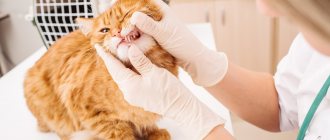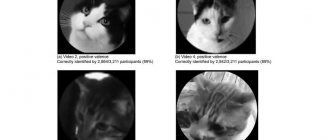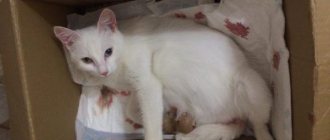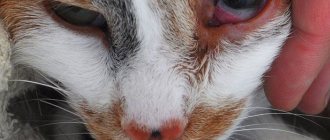Risks of the condition
Regular or large amounts of blood loss can weaken even the strongest organism, which cannot cope with bleeding on its own without outside intervention. Severe blood loss in a cat can result in the following:
A single bleed in a cat is not dangerous.
- disruption of mechanical circulatory function;
- insufficient filling of blood vessels and cardiac compartments with blood;
- falling blood pressure;
- a sharp decrease in red blood cells and a drop in hemoglobin levels leads to the development of anemia;
- tissue hypoxia (oxygen starvation) due to a disrupted process of oxygen transfer through vessels to tissues and organs;
- disruption of local metabolic processes, which leads to massive cell death, and then the death of the organism.
Treatment
In case of internal bleeding or suspicion of it, you need to take your pet to a veterinary hospital as quickly as possible. If there is gastric bleeding, cold can be applied to the animal's stomach.
In case of external bleeding, it is advisable to temporarily stop the bleeding and take the cat to the doctor. If an animal has a broken limb, it needs to be fixed. Sometimes it is very difficult for an animal to apply a splint, then experts advise fixing the limb to the body using elastic fabric, for example, tights.
Capillary bleeding usually does not require intervention; the cat licks minor abrasions well. To avoid penetration of pathogenic microorganisms into the wound, it can be treated with a solution of brilliant green or any alcohol solution. You can apply a bandage if necessary.
In case of venous bleeding, the blood is stopped by finger pressure. This is the best way to stop and control bleeding.
A sterile pressure bandage can be applied.
If there is bleeding from the arteries, a tourniquet must be applied.
A tourniquet is applied above the site of vessel damage. In summer, you can apply a tourniquet for a time not exceeding one and a half hours, in winter - for an hour. Every 30-40 minutes, the tourniquet must be loosened by pressing the bleeding vessel with a finger. The compressive force of the tourniquet should be sufficient to stop the bleeding, but not too strong, otherwise it will lead to loss of the limb.
If the face, eyelids, or eyes are damaged, you need to apply a sterile bandage to the wound and take the cat to the doctor as quickly as possible.
Overt and hidden internal bleeding
Discharge from a pregnant cat: bloody, yellow
It is impossible to see internal bleeding in a cat. But some similar processes are manifested by certain external symptoms and are called overt internal bleeding.
Table of external symptoms of obvious internal bleeding:
| Type of obvious internal bleeding | Accompanying external symptoms |
| Esophageal | Vomiting with bright scarlet blood. |
| Gastric | Burgundy or brown clots of coagulated blood in the vomit. |
| Intestinal | Burgundy or brown clots of coagulated blood in vomit (small intestine) and/or stool with traces of dark blood or black in consistency like coffee grounds (lower intestines). |
| Pulmonary | Wet cough with bloody foam. |
| Royal | Bloody discharge from the loop. |
| Renal | Blood or traces of it in every urine sample. |
External symptom of obvious internal bleeding
Causes of bleeding in cats
A cat has a nosebleed: causes and diagnosis
There are many reasons explaining this condition.
Pyometra
In cats, bleeding from the vagina is a frequent companion to a disease such as pyometra. The development of this disease is most often provoked by an excess amount of progesterone in the cat’s body, which is produced in the following cases:
- uncontrolled use of hormonal contraceptives to prevent pregnancy;
- poor hygiene during estrus;
- violation of sanitary standards during childbirth;
- uncontrolled matings;
- impaired immunity, congenital hormonal changes;
- lack of physical activity.
Those at risk most often are elderly, nulliparous, pregnant cats with pathologies, including those who gave birth prematurely.
A cat with pyometra suffers a lot of pain
Endometritis
Endometritis is an inflammation of the walls of the uterus, often accompanied by a purulent process that further damages the organ, which provokes uterine bleeding. The greatest danger is the development of the disease in the postpartum period, when the uterine tissue has not yet recovered, and the slightest damage leads to copious bloody discharge from the cat’s uterus.
Note! It is recommended to sterilize the young female to prevent the development of endometritis and pyometra.
Bleeding disorder
Bleeding disorders in cats can be present from birth or develop later in life. Defects in the protein responsible for coagulation provoke prolonged blood flow and the formation of hematomas in the deep layers of tissue. Platelet defects result in frequent superficial bruising, nosebleeds, black, pasty stools when the intestines are damaged, and difficulty stopping blood after injections or surgery.
One of the symptoms of a bleeding disorder is that the blood does not stop well when the ear is damaged.
Congenital bleeding disorders include hemophilia type A, B, von Willebrand disease, Chediak-Higashi syndrome, Ehlers-Danloos syndrome, known as cutaneous asthenia.
For your information! The clotting process can be disrupted by pet poisoning with rat poison, weakened immunity and infectious diseases such as viral leukemia, infectious peritonitis, feline distemper or toxoplasmosis, as well as chronic diseases of internal organs.
Disorders of the reproductive system
In some cases, a cat that has undergone sterilization may experience an increase in mammary glands. This complication is associated with the development of a false pregnancy in the cat, which occurred even before the operation. However, swollen mammary glands can also be a symptom of mastitis, so it would be a good idea to take your cat to the vet again.
It happens that after sterilization a cat begins to discharge pus with blood. This is most likely due to inflammation of the uterine stump, and if this happens, then another operation will have to be performed, during which the cat’s uterine stump will be shortened.
Some cats continue to be in heat even after sterilization. This happens because the animal’s hormonal background changes slowly, and the body continues to produce substances that regulate the estrus mechanism. Usually, after one and a half to two months, estrus completely stops bothering the cat, but if this phenomenon continues, you should visit a veterinary clinic, as there is a possibility that the ovaries and uterus were not completely removed. In such a case, repeat surgery will be required.
In cats, bloody discharge from the vaginal area can occur for various reasons. In some cases this is a physiological norm, in others it is a symptom of a disease. What to do if a cat is bleeding from a noose, how to distinguish between a normal process and pathology? Any owner of a female should know in which cases to sound the alarm and take the animal to the veterinarian, and in which cases there is no need to worry.
Symptoms of bleeding from the uterus in a cat
The cat has bleeding on the second day after giving birth
Due to uterine bleeding, the cat becomes lethargic and apathetic, she has a refusal to eat, pale visible mucous membranes (tongue, gums, ear, nose) and sensitive hypothermia of the paws. Such symptoms indicate insufficient blood supply to body tissues.
Note! During intrauterine bleeding, blood in a cat rarely leaks onto the external genitalia, as it accumulates in the uterine cavity.
According to statistics, about 70% of bleeding develops according to a moderate principle, that is, the accompanying symptoms appear and increase over several days or weeks. The pet gradually becomes more and more phlegmatic, lethargic, begins to sleep more and more, loses appetite and loses weight, and the stomach, on the contrary, swells like a balloon due to the blood accumulating inside the uterus.
The main symptom of cat uterine bleeding is lethargy.
Endometritis
Inflammation of the uterine mucosa. The cause is genital infections. Animals walking on the street, young cats under 3 years of age, when using hormonal drugs for estrus, an unbalanced diet, difficult childbirth, and a hereditary tendency are at risk.
The disease is considered in acute or acquired form. Let's look at the symptoms. In the acquired form, symptoms are mild. The pet looks healthy in appearance, but often licks itself, so the cat’s blood from the uterus is not visible. The danger is that this form can become purulent. This is due to increased accumulation of secretions due to thickening of the uterine mucosa. The secretion is a favorable environment for the development of infections. Characterized by copious discharge and increased body temperature. Urgent medical assistance is required.
Symptoms in acute form:
- temperature increase;
- loss of appetite;
- copious discharge from the genital opening;
- often arches his back and assumes a posture for urination;
- abdominal enlargement;
- the external genitalia are inflamed.
At an early stage, antibiotics and antimicrobials are used. In case of purulent form, sterilization is carried out. To increase the body's defenses, immunomodulators are prescribed.
What to do if your cat is bleeding
A pet with bleeding requires an urgent professional examination, which will establish the correct diagnosis and prescribe the necessary treatment. Attempts to stop prolonged or heavy blood loss using folk remedies can lead to the death of the cat. This is especially true in cases of bleeding in a kitten, since there is little blood in its body, and the loss of even the smallest dose can provoke the death of the baby.
Did your cat fall out of a window, get hit by a car, or become a victim of a beating? It is highly recommended that you visit a veterinarian, even if there are no visible injuries and your pet appears normal. Internal bleeding that does not open immediately after an injury can appear at any time due to a burst hematoma or a purulent process. It is recommended to carefully move the injured animal into a box with a hard bottom in order to eliminate complications from a possible spinal fracture.
Professional veterinary care
A cold compress is applied to the suspected bleeding site. If possible, the mouth and airways are carefully cleared of blood or vomit. It is strictly forbidden to feed or water an injured cat. If your pet loses consciousness, it is not recommended to stir, trying to bring him back to his senses, as such actions can aggravate the condition.
Note! If a cat is bleeding profusely from the uterus, you can give it water or warm broth and urgently visit a veterinarian or call him at home.
Diagnostic methods
If the doctor suspects such a condition in a fluffy dog, then he must undergo an ultrasound of the organs located in the peritoneum.
As soon as your cat develops symptoms of internal bleeding, you should immediately contact a veterinary clinic, where the pet will be examined and a comprehensive examination will be prescribed to determine the source of the problem and assess its severity. In case of violation, the following procedures must be followed:
- X-rays of the peritoneum;
- puncture of the abdomen using a needle or syringe and laboratory examination of the resulting sample;
- detailed blood test;
- coagulogram;
- ultrasound diagnostics of the abdominal organs;
- CT and MRI.
Veterinarians warn that a comprehensive examination is carried out only after internal bleeding has stopped and the cat’s condition has stabilized.











